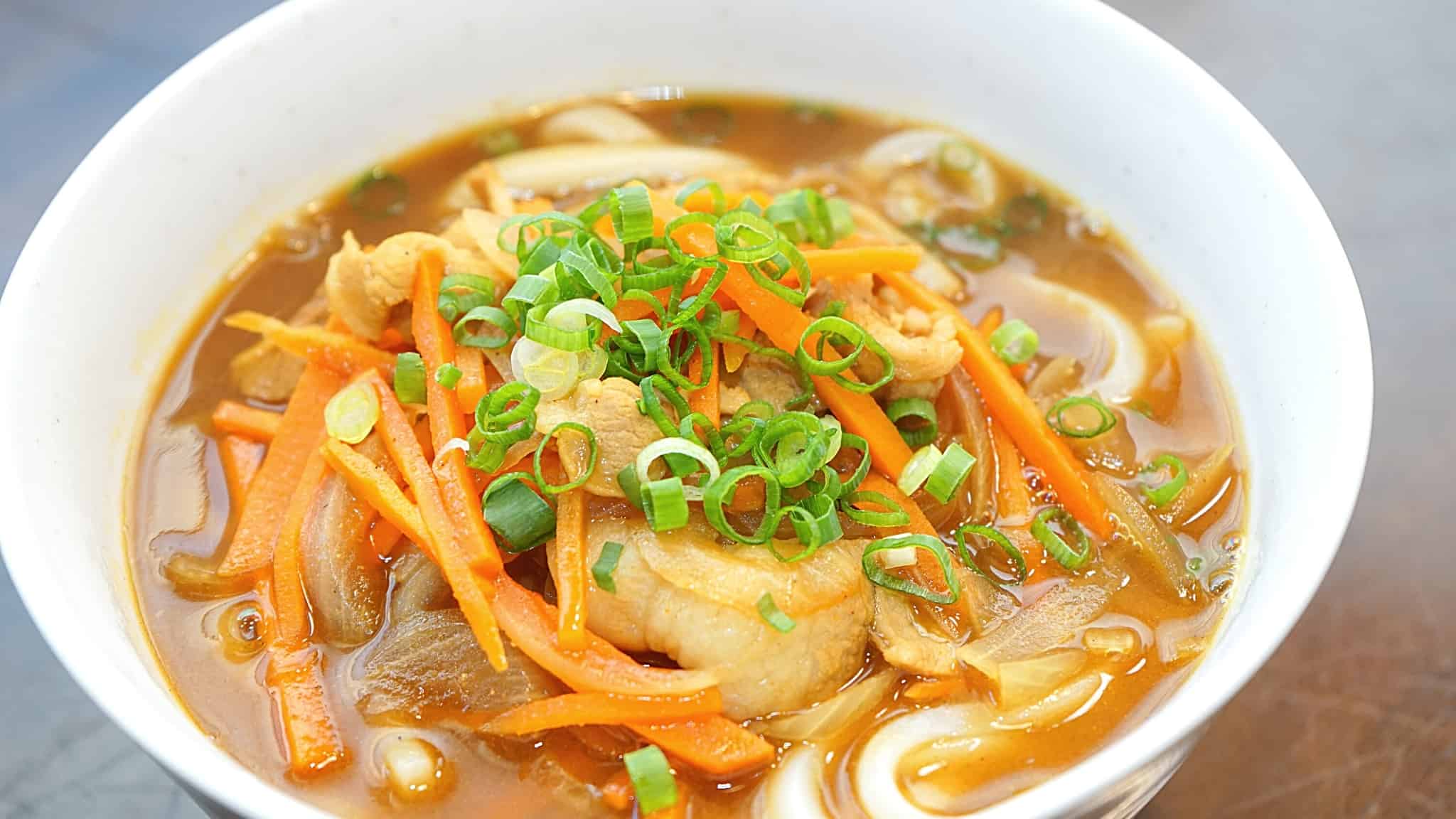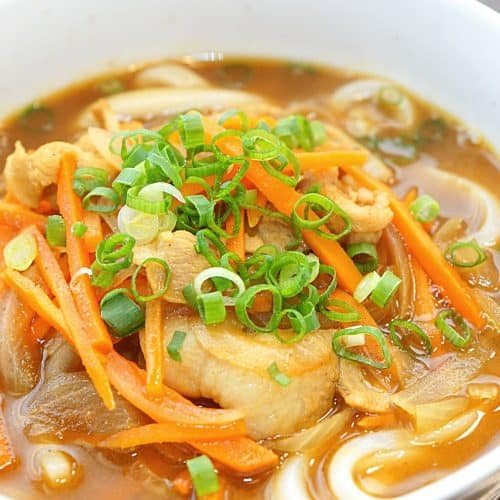Japanese curry udon: fast, versatile and delicious
Most people associate curry with rice, but have you tried the delicious pairing between curry and thick chewy udon noodles?
In this dish, curry udon noodles are covered in a thick broth made with curry roux, dashi stock, mirin, and soy sauce.
It’s not quite a soup, but not a stew either and that rich flavor of curry with thin strips of beef and the slurpy noodles in a thick broth is just too delicious to pass up.

Curry udon is what I consider tasty comfort food. You can make it on cold days, but you can always make it vegan for those warm summer days when you want a light meal.
Thus, it’s such a versatile dish and it takes less than 30 minutes to make, so you can whip it up whenever you feel hungry.
I’m sharing this curry udon noodle recipe with beef and mushrooms the whole family will enjoy!

Check out our new cookbook
Bitemybun's family recipes with complete meal planner and recipe guide.
Try it out for free with Kindle Unlimited:
Read for freeIn this post we'll cover:
What is Japanese curry udon?
When you think of udon, the first recipe that comes to mind is a bowl of thin soup with thick udon noodles and some light toppings.
But, curry udon is a great rich flavorful alternative to basic udon noodle soup. The meat adds more flavor and makes this a complete meal you can enjoy throughout the day.
Curry udon is different from the curry you pair with rice. It’s more brothy than sauce-like. So, don’t expect similar textures and flavors.
Japanese curry is called curry roux, and it is different from Indian or Thai curry recipes. In terms of texture, it is much thicker and has the consistency of a beef stew.
Flavorwise, it is sweeter and milder. Don’t expect too much spiciness from Japanese curry and instead enjoy the light flavors of this dish.
The curry is thinned out with dashi soup stock for curry udon, so the dish has the consistency of a thick broth. Then, you add in chewy udon noodles and a source of protein (beef, pork, chicken, seafood, or tofu).
The topping is simple: chopped scallions for a final burst of flavor.
Of course, some restaurants will add more decorative elements like deep-fried tofu and fish cakes, but the most important ingredient in terms of flavor is the curry.
Also read: Japanese Curry Recipes | Beef Roux from scratch & 6 more recipes

Japanese beef curry udon recipe
Ingredients
- 2 packages of udon noodles frozen, refrigerated, or dry are all fine
- 100 grams beef sliced into thin strips top sirloin or ribeye is best
- 100 grams onions
- 100 grams shimeji mushrooms oyster or straw mushrooms are good too
- ½ carrot sliced a la julienne thin strips
- 2 spring onions scallions chopped
- 1 tbsp canola or vegetable oil
- 500 ml dashi stock
- 2 curry roux cubes or 2 tbsp of curry powder
- 2 tsp sugar
- 1 tsp mirin
- 1 tsp soy sauce
Instructions
- First, chop the onion, carrots, mushrooms, and spring onions. Set the spring onion aside for garnishing the noodles later on.
- Slice the beef into very thin strips.
- In a pot, heat up the oil and sautee the onions, carrots, and mushrooms for approximately 1 minute.
- Add in the beef strips and sautee on medium-high heat until the beef browns. The beef should no longer be red in color.
- Pour the dashi stock and the two curry cubes. Mix well until the cubes dissolve completely.
- Add the sugar, mirin, and soy sauce and let the mixture boil on medium heat. You can remove any foam with a small strainer or spoon.
- The sauce should begin to thicken and once it has thickened enough, turn the heat off.
- In a separate pot boil water, add the udon noodles, and cook them for about 1 minute (or according to package instructions). Note: frozen and dry noodles have differing cooking times.
- Split the udon noodles into two bowls and add curry to both. Garnish with spring onion and serve hot.
Notes
Japanese curry udon: nutritional information
A bowl of curry udon has approximately:
- 520 calories
- 60 grams of carbohydrates
- 14 grams of fat
- 28 grams of protein
- 1050 mg of sodium
It is also a source of vitamins A & C, calcium, and iron.
Udon noodles are high in fiber, a source of B vitamins, and vegan-friendly. They are made of wheat and water, so they are healthier than some other noodles like ramen.
But, what adds calories to this dish is the curry roux cubes which have a high fat, sugar, and sodium content.
If you’re looking for a diet-friendly udon recipe, I recommend kitsune udon noodle soup.
Japanese curry udon: recipe variations
What I like about curry udon is that you can make it with any type of meat. Here’s what I recommend:
- Thin chicken strips
- Thin pork loin slices of pork belly
- Shrimp
- Fish
If you’re vegan or vegetarian, then you can always skip the meat and use tofu or other vegan ingredients like:
- Boiled tofu
- Aburaage (deep-friend tofu)
- Shiitake mushrooms
- Snap peas
- Diced potatoes
If you add tofu to your curry udon, consider aburaage (deep-fried tofu pockets) because it adds a texture similar to meat.
For the stock, kombu dashi is the best choice for vegans because it’s made of seaweed or shiitake mushrooms, not bonito flakes.
In some parts of Japan, curry udon is topped with a jelly-like fish cake, called Chikuwa. It has a tube shape and it’s mostly made of sea bream and cod. It adds some texture and fishy flavor to the noodles.
Other popular curry udon ingredients and toppings include:
- Egg
- Naruto fish cake
- Toasted sesame seeds
- Ginger
- Seaweed
- Togarashi spice mix seasoning
Tip: If you have leftover curry sauce from other dishes, you can add a bit of dashi stock, dilute it with water, add udon noodles and you’ve got a vegetarian curry udon type dish made with leftovers!
How to serve Japanese curry udon & what to pair it with
In most restaurants, curry udon is eaten with a big Western-style spoon to make it easy to get a mouthful of both noodles and broth at once. It’s served in a bowl with fresh toppings while it’s still warm.
Although curry udon is a winter favorite, many people make or buy this dish year-round because it’s such a comforting and hearty food.
Since curry udon is quite a filling dish, you usually just eat a bowl of it for lunch or dinner.
As a side dish, you can have fukujinzuke which is a mix of pickled vegetables with a sweet taste, or pickled scallions, called rakkyo.
But, most people keep it simple and enjoy the curry noodles without any side dishes.
Origin of Japanese curry udon
Udon noodles are a yummy thick and chewy noodle variety made from wheat flour.
It’s believed that udon noodles originated in China and were imported into Japan during the Tang dynasty, between the years 618-907 CE. Udon was sold at food stalls as early as the 17th century because it was a quick and tasty meal.
Curry udon most likely originated in the Tokyo region sometime in the Meiji period (1868-1912). The curry was imported from India and since the Japanese preferred a more mild version, they created curry roux.
Noodles were another Japanese favorite, so it’s only natural that they combined the curry with the noodles.
Are you craving the noodles yet? Be sure to give this recipe a try, and it might quickly become a family favorite year-round.
If you’re a curry fan, it’s definitely going to satisfy the curry craving but with noodles, it’s a nice alternative to rice.
Next, check out this Teppanyaki Hibachi Noodle Recipe you’ll love! | Top 3 recipes
Check out our new cookbook
Bitemybun's family recipes with complete meal planner and recipe guide.
Try it out for free with Kindle Unlimited:
Read for freeJoost Nusselder, the founder of Bite My Bun is a content marketer, dad and loves trying out new food with Japanese food at the heart of his passion, and together with his team he's been creating in-depth blog articles since 2016 to help loyal readers with recipes and cooking tips.
